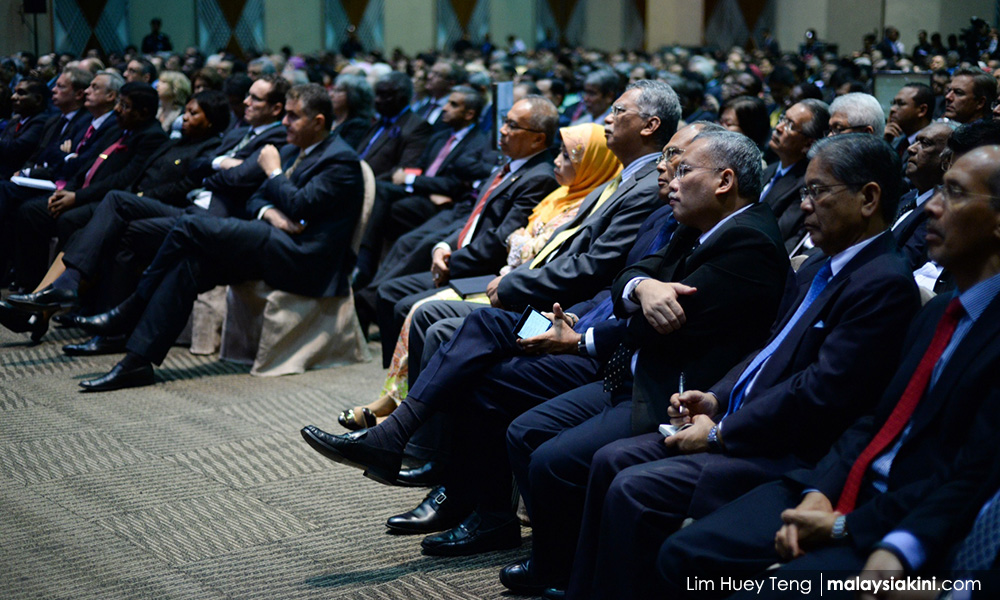The ongoing debate on the future of government-linked companies (GLCs) and their management is complex and multifaceted. These articles contributing to this discussion are based on the third Tun Hussein Onn Chair lecture delivered by Jomo KS, now a member of the Council of Eminent Persons.
COMMENT | In discussing state-owned enterprises (SOEs), particularly vis-à-vis private enterprises and privatisation, it is tempting but usually misleading to generalise too readily.
Why SOEs?
Historically, the private sector has been unable or unwilling to affordably provide needed services. Hence, such important matters could not just be left to the market or private interests. Thus, SOEs were created during the colonial period owing to ‘market failure’ as the private sector was simply not meeting the needs of colonial capitalist expansion.
Thus, the establishment of government departments, statutory bodies or even government-owned private companies were deemed important, if not essential, for maintaining the status quo and advancing particular powerful and influential interests.
SOEs have also been established to advance national public policy priorities. Again, these emerge owing to ‘market failures’ for those who naively believe that markets will serve national public policy purposes.
However, neoliberal or libertarian economists do not recognise the existence of national or public interests, characterising all associated policies as mere subterfuges for advancing particular interests under such guises.
Nevertheless, regardless of their original rationale or intent, many SOEs have undoubtedly become problematic and often inefficient. Yet, privatisation is not, and has never been, a universal panacea to the myriad problems faced by SOEs.
Causes of SOE inefficiency
Undoubtedly, the track records of SOEs are very mixed and often vary by sector, activity and performance, with different governance and accountability arrangements. While many SOEs may have been quite inefficient, it is important to recognise and address such inefficiencies rather than simply hope for the best from privatisation.
First, SOEs often suffer from unclear or sometimes even contradictory objectives. Some SOEs may be expected to deliver services to the entire population or to reduce geographical imbalances. Other SOEs may be expected to enhance growth, promote technological progress or generate jobs. Overregulation may exacerbate such problems by imposing contradictory rules.
To be sure, unclear and contradictory objectives – such as to simultaneously maximise sales revenue, address disparities and generate employment – often mean ambiguous performance criteria, and leave it open to abuse.
Typically, SOE failure by one criterion (such as cost efficiency) was excused on the grounds of fulfilling other objectives (such as employment generation). Importantly, such ambiguity of objectives is not due to public or state ownership per se.

Second, the performance criteria for evaluating SOEs as well as privatisation are often ambiguous. SOE inefficiencies have often been justified by other public policy objectives, such as the New Economic Policy (NEP), or bumiputera economic empowerment, affirmative action, or employment considerations.
Ineffective monitoring and poor transparency typically compromise SOE performance. Inadequate accountability requirements were a major festering problem as the public sector grew by leaps and bounds, especially in the 1970s, ostensibly to achieve NEP objectives, which were very loosely and broadly interpreted.
Third, coordination problems have often been exacerbated by inter-ministerial, inter-agency or inter-departmental rivalries. Some consequences included ineffective monitoring, inadequate accountability, or alternatively, over-regulation.
Generic hazards
Moral hazard has also been a problem as SOE managements expected sustained financial support from the government due to weak fiscal discipline or ‘soft budget constraints’. In many former state-socialist countries, such as the Soviet Union and Yugoslavia, due to such soft budget constraints, SOEs continued to be financed regardless of performance.
There have often been poor accountability requirements and arrangements for SOEs, as Permodalan Nasional Berhad’s Central Information Collection Unit (CICU) learned in the mid-1980s when it sought to catalogue existing public enterprises.
Overregulation has not been a solution, as it has generally proved to be quite ineffective. The monopoly status and powers of SOEs are widely acknowledged to have been abused, but privatisation would simply transfer such powers to private hands.
Very often, inadequate managerial and technical skills and experience have weakened SOE performance, especially in developing countries like Malaysia, where the problem has sometimes been exacerbated by considerations of ethnic privilege, legitimised in terms of the need for affirmative action.
Often, SOE managements have lacked adequate or relevant skills, but have also been constrained from addressing them expeditiously. Privatisation, however, does not automatically solve the lack of such managerial skills.
Similarly, the privatisation of SOEs which are natural monopolies (such as public utilities) will not overcome inefficiencies due to the monopolistic or monopsonistic nature of the industry or market. The key remaining question is whether privatisation is an adequate or appropriate response to address SOE problems.
SOEs often enjoy monopolistic powers, which can be abused, and hence require appropriate checks and balances. In this regard, there are instances where privatisation may well be best. Two examples from Britain and Hungary may be helpful.

The most successful case of privatisation in the United Kingdom during the Margaret Thatcher period involved National Freight through a successful Employee Stock Ownership Plan (ESOP). The ESOP meant that the truck drivers and other staff co-owned National Freight and thus had personal stakes in making it a success.
In Hungary, the state got involved in running small stores. Many were poorly run due to overcentralised control. After privatisation, most were more successfully run by the new owners who were previously store managers.
Hence, there are circumstances where privatisation can result in desirable outcomes, but one cannot presume from citing a few such examples that privatisation is the answer to all SOE problems.
Privatisation has never been a universal panacea. One has to understand the specific nature of a problem; sustainable solutions can only come from careful understanding of the specific problems to be addressed.
The debate
Several arguments have been advanced to justify privatisation in Malaysia since the mid-1980s. Privatisation was advocated as an easy means to:
- Reduce the financial and administrative burden of the government, particularly by undertaking and maintaining services and infrastructure;
- Promote competition, improve efficiency and increase productivity in the delivery of public services;
- Stimulate private entrepreneurship and investment to accelerate economic growth; and
- Help reduce the presence and size of the public sector, with its monopolistic tendencies and bureaucratic support.
First, privatisation is supposed to reduce the financial and administrative burden of the government, particularly in providing services and infrastructure. The rapid expansion of the public sector in the 1970s and early 1980s was increasingly seen as problematic. Thus, reducing the government’s role and burden was seen as likely to be popular.
Second, privatisation was portrayed as a measure to promote competition, improve efficiency and increase productivity in service delivery. This belief was naïve, confusing the issue of property rights with that of promoting competition.
It was believed that privatisation would somehow encourage competition, not recognising that competition and property rights are distinct, and not contingent issues. Associated with this was the presumption that competition would automatically result in greater efficiency as well as improved productivity, not recognising the economies of scale and scope in many instances.
Third, privatisation was expected to stimulate private entrepreneurship and investment. There is also a popular, but naïve belief that privatisation was going to stimulate private entrepreneurship when, in fact, the evidence is strong in Malaysia and elsewhere that privatisation crowds out the likelihood of small and medium-sized enterprises actually emerging to fill the imagined void, which is supposed to exist following privatisation.
Admittedly, there is scope for new entrepreneurship with privatisation as new ways and ideas offered by the private sector are considered – or reconsidered – as the new privatised entity seeks to maximise the rents which can be secured with privatisation.
However, the private purchase of previously public property does not augment real economic assets. Private funds are thus diverted and consequently diminished, rather than augmented, to take over previous SOEs. Hence, available private funds are less available for investing in the real economy, in new economic capacities and capabilities.
Fourth, privatisation was supposed to reduce public sector monopoly, but there is little evidence of significant erosion of the monopolies enjoyed by privatised SOEs. Arguably, technological change and innovation, such as in telecommunications, were far more significant in eroding privatised monopolies and in reducing costs to consumers, than the changes in property rights implied by privatisation.
From the 1980s, various studies portrayed the public sector as a cesspool of abuse, inefficiency, incompetence and corruption. Books and articles with pejorative titles, such as ‘vampire state’, ‘bureaucrats in business’ and so on provided the justification for privatisation policies.

Undoubtedly, there were some real horror stories, which were conveniently cited as supposedly representative of all SOEs. But, other experiences can also be cited to show that SOEs can be run quite efficiently, even on commercial bases, confounding the dire predictions of the prophets of public sector doom.
Improved efficiency?
Although there are cases where SOEs have been better run and deemed more efficient after privatisation, the overall record has not been consistent. It is important to ascertain why there have been improvements or otherwise. It is also important to remember that better-run privatised SOEs in and of themselves do not necessarily serve the national or public interest better.
Undoubtedly, SOEs can generally be better run and most can become more efficient. But this is not always the case as some SOEs are indeed well-run. For instance, very few privatisation advocates would insist that most SOEs in neighbouring Singapore are poorly run.
While SOEs are generally well-run, public ownership cannot be used as an excuse for poor governance, management or abuse, but precisely the converse is true. As a matter of fact, the overall share of the economy controlled by the city-state is far greater than in Malaysia.
Hence, in different contexts, with appropriately strict supervision, SOEs can indeed be better run. Privatisation, in itself, will not solve managerial delegation problems, i.e., the principal-agent problem, as it is not a question of property rights per se.
With SOEs, the principal is the state or the government while the agents are the managers and supervisors, who may or may not necessarily pursue the objectives intended by the principal. This is a problem faced by many organisations. It is also a problem for private enterprises or corporations, especially large ones, where the principal may not be able to exercise effective supervision or control over the agent.
Also, natural monopolies (such as public utilities) are often deemed inefficient due to the monopolistic nature of the industry or market. The question then is whether the alternative, which is private monopoly, is the superior solution, even with regulation intended to protect the public interest.
The answer needs to be ascertained analytically on the basis of evidence, and cannot be presumed a priori. If an industry is a natural monopoly, what does privatisation achieve? Often, it means a transfer to private hands, which can be problematic and possibly dangerous for the public interest.
Part 1: Privatisation of state-owned enterprises - how it began and spread
Part 3: Has privatisation benefitted the public and consumers?
Part 4: Privatisation: Is the solution worse than the problem?
Part 5: Reforming our government-linked companies
Part 6: Public-private partnerships – the recent fad of PPPs
JOMO KS was economics professor and Assistant Secretary General for Economic Development at the United Nations. He held the chair at the Institute for Strategic and International Studies (ISIS) Malaysia in 2016-17.
The views expressed here are those of the author/contributor and do not necessarily represent the views of Malaysiakini.

